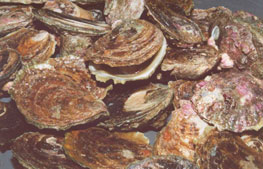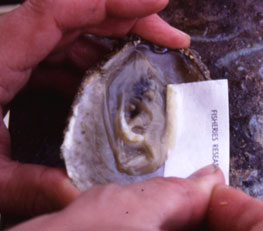Diseases of molluscs
Parasitic diseases—Infection with Bonamia exitiosa
CLICK ON IMAGE TO ENLARGE

Source: B Diggles
CLICK ON IMAGE TO ENLARGE

Source: B Jones
Signs of disease
Important: animals with disease may show one or more of the signs below, but disease may still be present in the absence of any signs.
Disease signs at the farm level
Infection with species of Bonamia rarely results in clinical signs of disease in oysters. More often, the only visual cue is increased mortality.
Clinical signs of disease in an infected animal
Heavy infections may show:
- undergrown oysters, in poor condition
- weakened shell closure, leading to slight gaping
- watery flesh
- high mortalities of oysters in initial outbreak
- algae-covered shell lips after mantle shrinks and no longer reaches edges
- deformities to gill margins
Disease agent
Bonamia spp, including B. exitiosa, are protists (intrahaemocytic protozoa) of the phylum Haplosporidia that cause lethal infection of the haemocytes of certain oysters. Evidence suggests that B. exitiosa in New Zealand may be conspecific with Bonamia sp in Australia. However, until further research establishes this relationship, Bonamia exitiosa and the Australian Bonamia are currently considered to be different species.
Host range
Molluscs known to be susceptible to the disease:
New Zealand dredge oyster* (Ostrea chilensis)
southern mud oyster* (Ostrea angasi)
* naturally susceptible
Presence in Asia–Pacific
While Bonamia exitiosa is not officially reported under the NACA–FAO–OIE quarterly aquatic animal disease reporting program, it is known to be prevalent in the region.
Epidemiology
- Mortalities can occur all year, with highest prevalence in the mid to late summer.
- Bonamia exitiosa infects blood cells, destroying the immune system and interfering with other critical physiological processes.
- The disease dynamics of B. exitiosa in the New Zealand dredge oyster can be affected by exposure to extreme temperatures (below 7°C or above 26°C) and salinity (40‰), starvation (prolonged holding in filtered sea water), handling (vigorous stirring four times per day), or heavy infection with apicomplexan protists.
- Cohabitation of infected and uninfected oysters in holding tanks appears to promote the spread of infection.
- A seasonal pattern of disease has been observed since 1964, with two separate epizootics in 1985–1991 and 1998–2003 resulting in cumulative mortality of Ostrea chilensis of greater than 90%.
Differential diagnosis
The differential diagnostic table and the list of similar diseases appearing at the bottom of each disease page refer only to the diseases covered by this field guide. Gross signs observed might well be representative of a wider range of diseases not included here. Therefore, these diagnostic aids should not be read as a guide to a definitive diagnosis, but rather as a tool to help identify the listed diseases that most closely account for the gross signs.
There are few or no visual cues to the presence of this disease, other than poor condition, shell gaping and increased mortality. It is therefore not possible to differentiate between Bonamia spp based on gross symptoms alone. Any presumptive diagnosis requires histological laboratory examination.
Light microscopy can further define a diagnosis, but further laboratory examination is required for a definitive diagnosis.
Sample collection
Because of uncertainty in differentiating diseases using only gross signs, and because some aquatic animal disease agents might pose a risk to humans, you should not try to collect samples unless you have been trained. Instead, you should phone your national hotline number and report your observations. If samples have to be collected, the agency taking the call will advise you on what you need to do. Local or district fisheries/veterinary authorities could advise you on sampling.
Emergency disease hotline
For your national emergency disease hotline number, see Whom to contact if you suspect a disease.
Further reading
http://www.oie.int/aac/eng/cards/en_diseasecard.htm
http://www.pac.dfo-mpo.gc.ca/sci/shelldis/pages/bonamoy_e.htm
The currently accepted procedures for a conclusive diagnosis of infection with B.exitiosa are summarised at http://www.oie.int/eng/normes/fmanual/A_00038.htm
These hyperlinks were correct and functioning at the time of publication.

